Project Management Report: Western Australia Tank Repair Project
VerifiedAdded on 2021/04/21
|10
|1786
|400
Report
AI Summary
This project management report analyzes a case study involving the repair of three unleaded petrol storage tanks in Western Australia to prevent collapse and environmental damage. The project's goals include repairing the tanks with steel patches and anchors, cleaning, and repainting them. The scope is defined by tank accessibility constraints, the need for safety, and stakeholder considerations. Stakeholders include the Western Australian Storage Facility, Health, Safety, and Environment Manager, Project Manager, and Revenue Division. Deliverables include specific repair work on each tank, cleaning, and repainting. The project follows a waterfall approach, with lifecycle stages from resource planning to completion, considering scope changes. Success is measured by the project's environmental impact, addressing leakage, and adherence to the schedule. The report emphasizes the importance of stakeholder management, project scope definition, and the application of project management methodologies to ensure successful project outcomes and mitigate environmental risks.
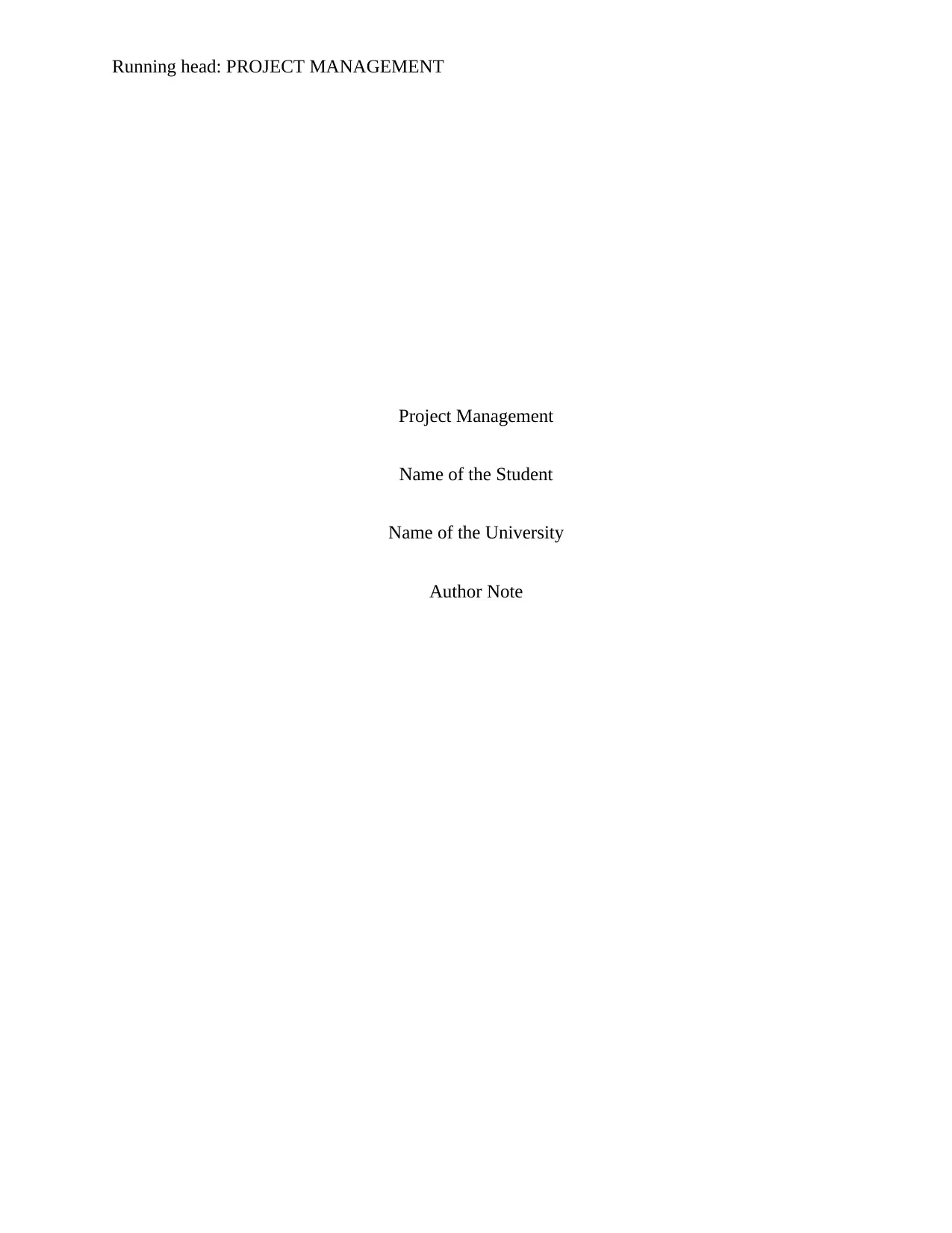
Running head: PROJECT MANAGEMENT
Project Management
Name of the Student
Name of the University
Author Note
Project Management
Name of the Student
Name of the University
Author Note
Paraphrase This Document
Need a fresh take? Get an instant paraphrase of this document with our AI Paraphraser
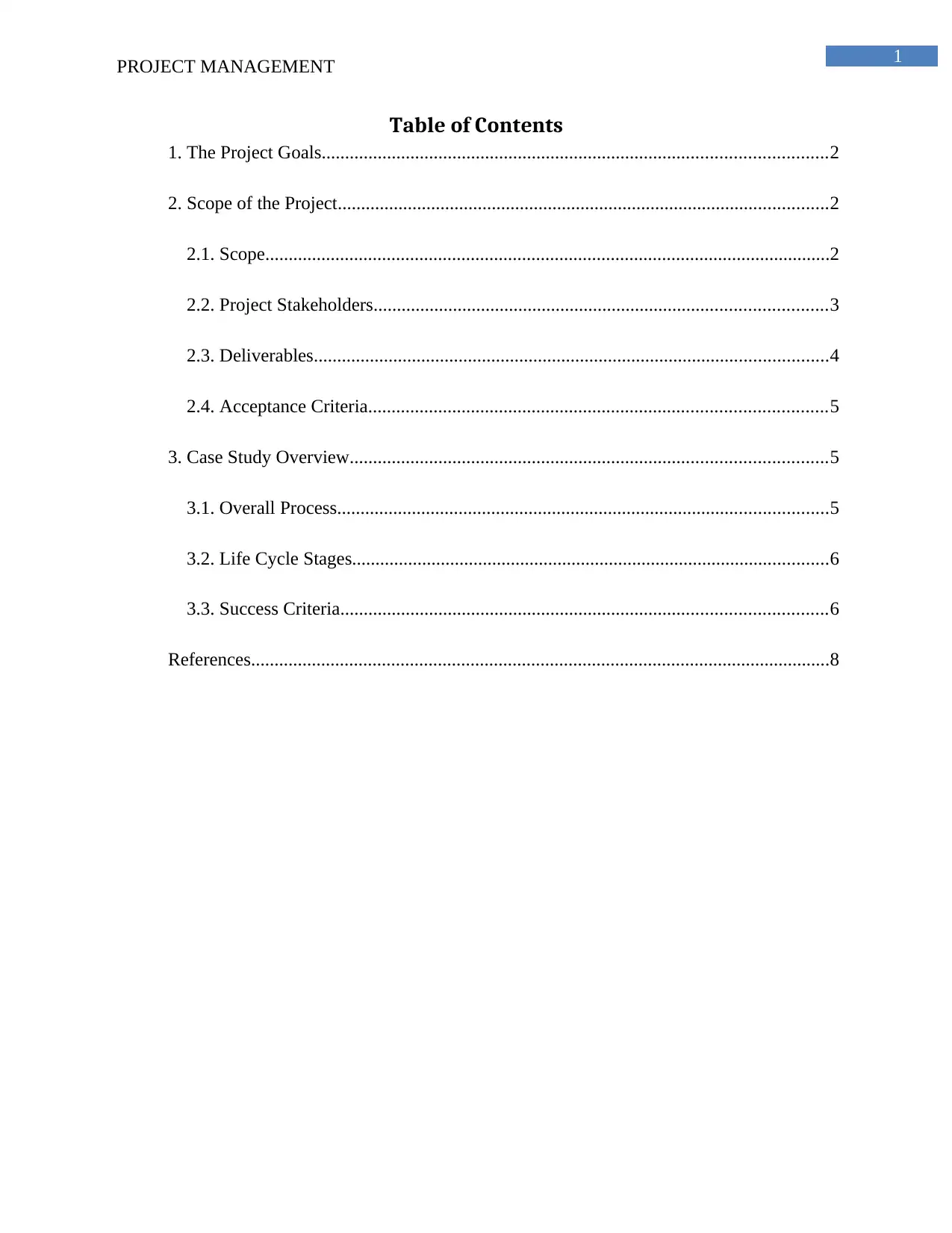
1
PROJECT MANAGEMENT
Table of Contents
1. The Project Goals............................................................................................................2
2. Scope of the Project.........................................................................................................2
2.1. Scope.........................................................................................................................2
2.2. Project Stakeholders.................................................................................................3
2.3. Deliverables..............................................................................................................4
2.4. Acceptance Criteria..................................................................................................5
3. Case Study Overview......................................................................................................5
3.1. Overall Process.........................................................................................................5
3.2. Life Cycle Stages......................................................................................................6
3.3. Success Criteria........................................................................................................6
References............................................................................................................................8
PROJECT MANAGEMENT
Table of Contents
1. The Project Goals............................................................................................................2
2. Scope of the Project.........................................................................................................2
2.1. Scope.........................................................................................................................2
2.2. Project Stakeholders.................................................................................................3
2.3. Deliverables..............................................................................................................4
2.4. Acceptance Criteria..................................................................................................5
3. Case Study Overview......................................................................................................5
3.1. Overall Process.........................................................................................................5
3.2. Life Cycle Stages......................................................................................................6
3.3. Success Criteria........................................................................................................6
References............................................................................................................................8
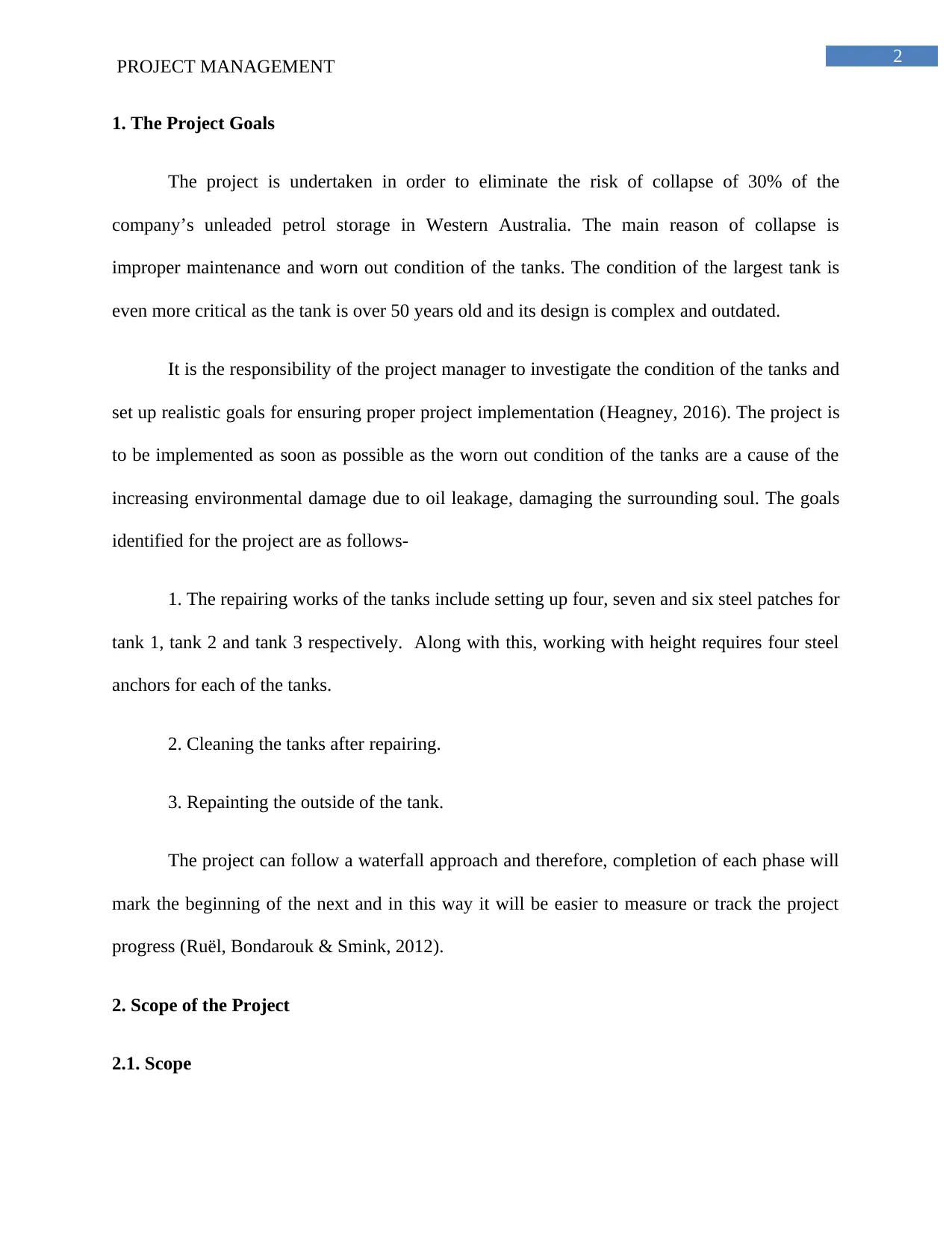
2
PROJECT MANAGEMENT
1. The Project Goals
The project is undertaken in order to eliminate the risk of collapse of 30% of the
company’s unleaded petrol storage in Western Australia. The main reason of collapse is
improper maintenance and worn out condition of the tanks. The condition of the largest tank is
even more critical as the tank is over 50 years old and its design is complex and outdated.
It is the responsibility of the project manager to investigate the condition of the tanks and
set up realistic goals for ensuring proper project implementation (Heagney, 2016). The project is
to be implemented as soon as possible as the worn out condition of the tanks are a cause of the
increasing environmental damage due to oil leakage, damaging the surrounding soul. The goals
identified for the project are as follows-
1. The repairing works of the tanks include setting up four, seven and six steel patches for
tank 1, tank 2 and tank 3 respectively. Along with this, working with height requires four steel
anchors for each of the tanks.
2. Cleaning the tanks after repairing.
3. Repainting the outside of the tank.
The project can follow a waterfall approach and therefore, completion of each phase will
mark the beginning of the next and in this way it will be easier to measure or track the project
progress (Ruël, Bondarouk & Smink, 2012).
2. Scope of the Project
2.1. Scope
PROJECT MANAGEMENT
1. The Project Goals
The project is undertaken in order to eliminate the risk of collapse of 30% of the
company’s unleaded petrol storage in Western Australia. The main reason of collapse is
improper maintenance and worn out condition of the tanks. The condition of the largest tank is
even more critical as the tank is over 50 years old and its design is complex and outdated.
It is the responsibility of the project manager to investigate the condition of the tanks and
set up realistic goals for ensuring proper project implementation (Heagney, 2016). The project is
to be implemented as soon as possible as the worn out condition of the tanks are a cause of the
increasing environmental damage due to oil leakage, damaging the surrounding soul. The goals
identified for the project are as follows-
1. The repairing works of the tanks include setting up four, seven and six steel patches for
tank 1, tank 2 and tank 3 respectively. Along with this, working with height requires four steel
anchors for each of the tanks.
2. Cleaning the tanks after repairing.
3. Repainting the outside of the tank.
The project can follow a waterfall approach and therefore, completion of each phase will
mark the beginning of the next and in this way it will be easier to measure or track the project
progress (Ruël, Bondarouk & Smink, 2012).
2. Scope of the Project
2.1. Scope
⊘ This is a preview!⊘
Do you want full access?
Subscribe today to unlock all pages.

Trusted by 1+ million students worldwide
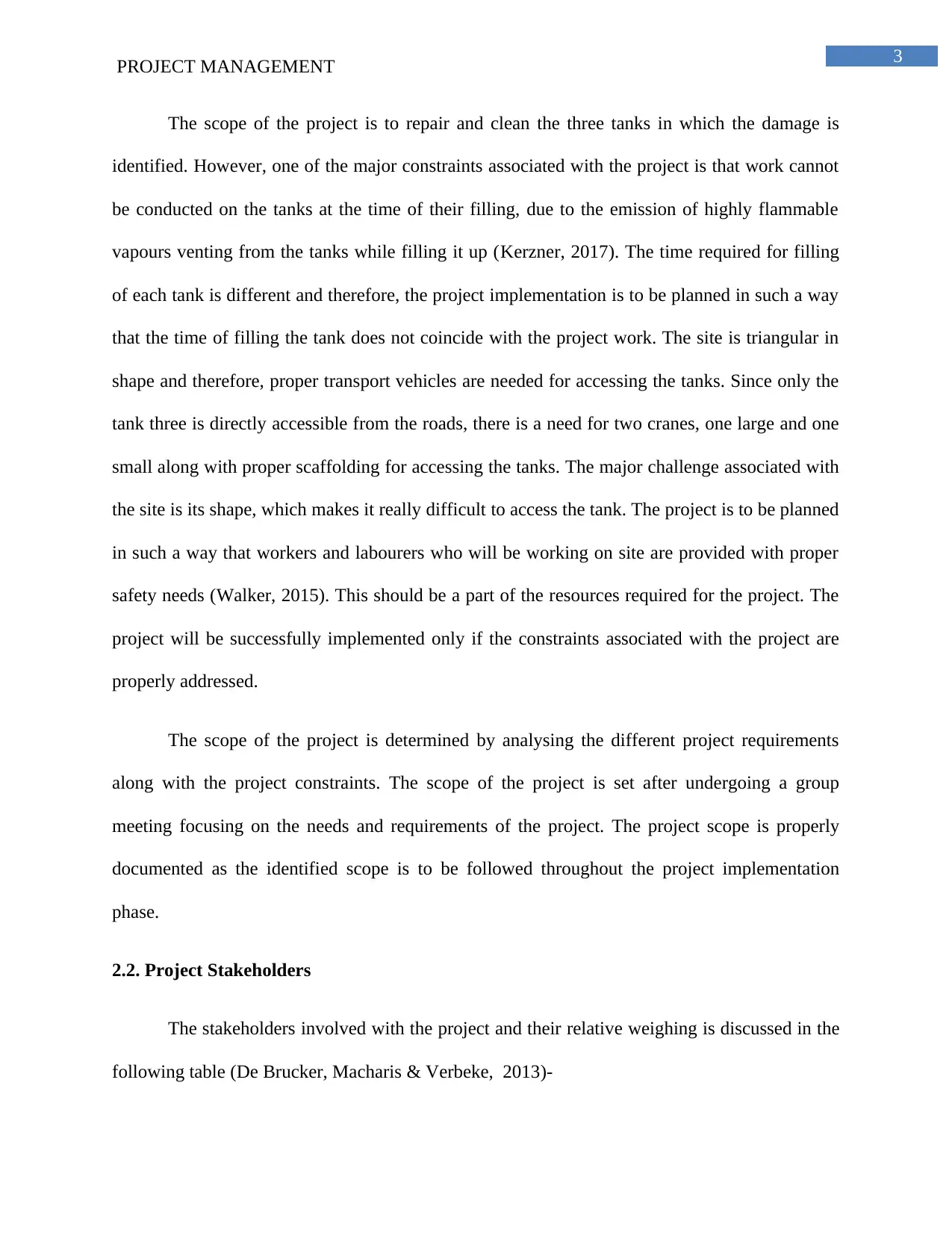
3
PROJECT MANAGEMENT
The scope of the project is to repair and clean the three tanks in which the damage is
identified. However, one of the major constraints associated with the project is that work cannot
be conducted on the tanks at the time of their filling, due to the emission of highly flammable
vapours venting from the tanks while filling it up (Kerzner, 2017). The time required for filling
of each tank is different and therefore, the project implementation is to be planned in such a way
that the time of filling the tank does not coincide with the project work. The site is triangular in
shape and therefore, proper transport vehicles are needed for accessing the tanks. Since only the
tank three is directly accessible from the roads, there is a need for two cranes, one large and one
small along with proper scaffolding for accessing the tanks. The major challenge associated with
the site is its shape, which makes it really difficult to access the tank. The project is to be planned
in such a way that workers and labourers who will be working on site are provided with proper
safety needs (Walker, 2015). This should be a part of the resources required for the project. The
project will be successfully implemented only if the constraints associated with the project are
properly addressed.
The scope of the project is determined by analysing the different project requirements
along with the project constraints. The scope of the project is set after undergoing a group
meeting focusing on the needs and requirements of the project. The project scope is properly
documented as the identified scope is to be followed throughout the project implementation
phase.
2.2. Project Stakeholders
The stakeholders involved with the project and their relative weighing is discussed in the
following table (De Brucker, Macharis & Verbeke, 2013)-
PROJECT MANAGEMENT
The scope of the project is to repair and clean the three tanks in which the damage is
identified. However, one of the major constraints associated with the project is that work cannot
be conducted on the tanks at the time of their filling, due to the emission of highly flammable
vapours venting from the tanks while filling it up (Kerzner, 2017). The time required for filling
of each tank is different and therefore, the project implementation is to be planned in such a way
that the time of filling the tank does not coincide with the project work. The site is triangular in
shape and therefore, proper transport vehicles are needed for accessing the tanks. Since only the
tank three is directly accessible from the roads, there is a need for two cranes, one large and one
small along with proper scaffolding for accessing the tanks. The major challenge associated with
the site is its shape, which makes it really difficult to access the tank. The project is to be planned
in such a way that workers and labourers who will be working on site are provided with proper
safety needs (Walker, 2015). This should be a part of the resources required for the project. The
project will be successfully implemented only if the constraints associated with the project are
properly addressed.
The scope of the project is determined by analysing the different project requirements
along with the project constraints. The scope of the project is set after undergoing a group
meeting focusing on the needs and requirements of the project. The project scope is properly
documented as the identified scope is to be followed throughout the project implementation
phase.
2.2. Project Stakeholders
The stakeholders involved with the project and their relative weighing is discussed in the
following table (De Brucker, Macharis & Verbeke, 2013)-
Paraphrase This Document
Need a fresh take? Get an instant paraphrase of this document with our AI Paraphraser
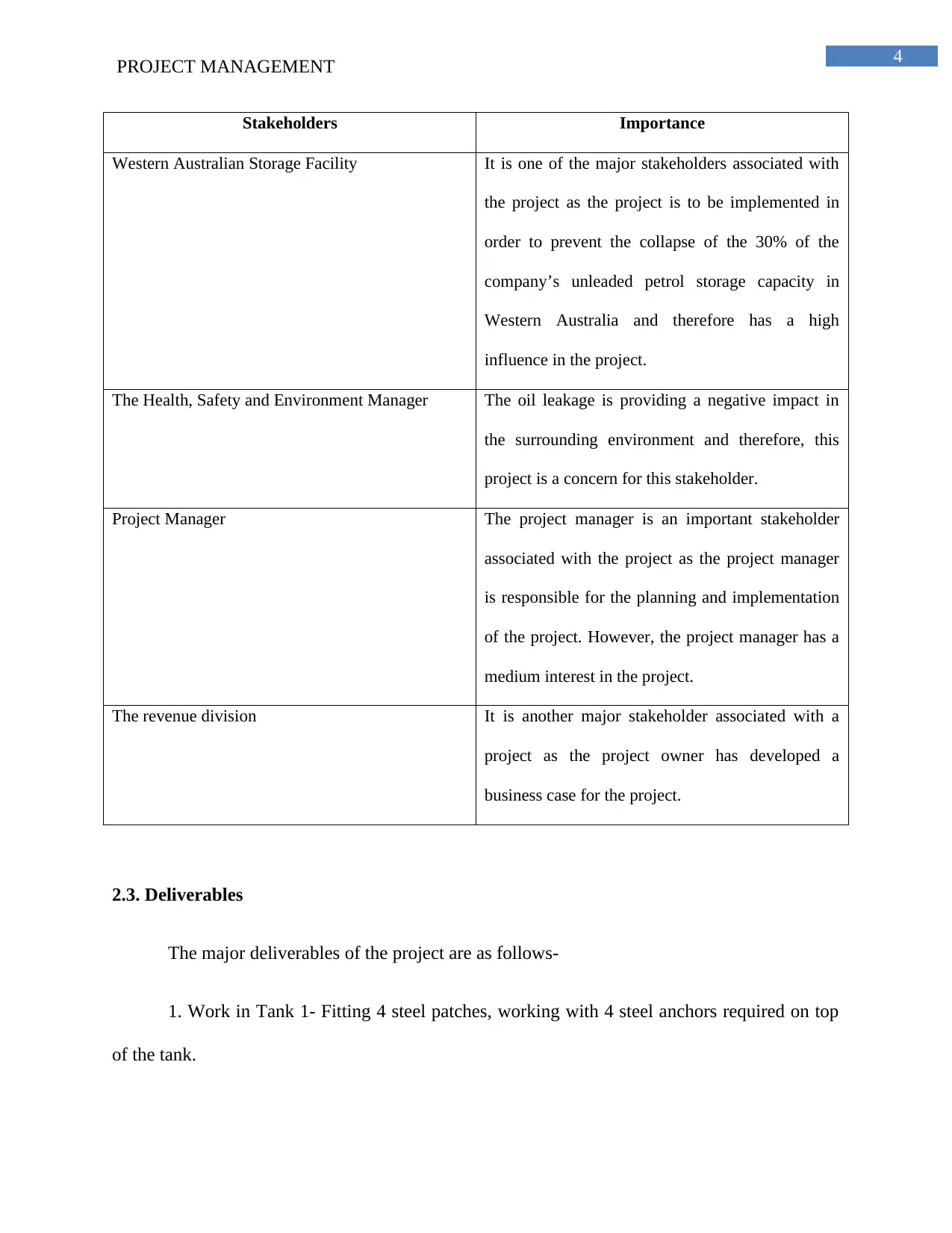
4
PROJECT MANAGEMENT
Stakeholders Importance
Western Australian Storage Facility It is one of the major stakeholders associated with
the project as the project is to be implemented in
order to prevent the collapse of the 30% of the
company’s unleaded petrol storage capacity in
Western Australia and therefore has a high
influence in the project.
The Health, Safety and Environment Manager The oil leakage is providing a negative impact in
the surrounding environment and therefore, this
project is a concern for this stakeholder.
Project Manager The project manager is an important stakeholder
associated with the project as the project manager
is responsible for the planning and implementation
of the project. However, the project manager has a
medium interest in the project.
The revenue division It is another major stakeholder associated with a
project as the project owner has developed a
business case for the project.
2.3. Deliverables
The major deliverables of the project are as follows-
1. Work in Tank 1- Fitting 4 steel patches, working with 4 steel anchors required on top
of the tank.
PROJECT MANAGEMENT
Stakeholders Importance
Western Australian Storage Facility It is one of the major stakeholders associated with
the project as the project is to be implemented in
order to prevent the collapse of the 30% of the
company’s unleaded petrol storage capacity in
Western Australia and therefore has a high
influence in the project.
The Health, Safety and Environment Manager The oil leakage is providing a negative impact in
the surrounding environment and therefore, this
project is a concern for this stakeholder.
Project Manager The project manager is an important stakeholder
associated with the project as the project manager
is responsible for the planning and implementation
of the project. However, the project manager has a
medium interest in the project.
The revenue division It is another major stakeholder associated with a
project as the project owner has developed a
business case for the project.
2.3. Deliverables
The major deliverables of the project are as follows-
1. Work in Tank 1- Fitting 4 steel patches, working with 4 steel anchors required on top
of the tank.
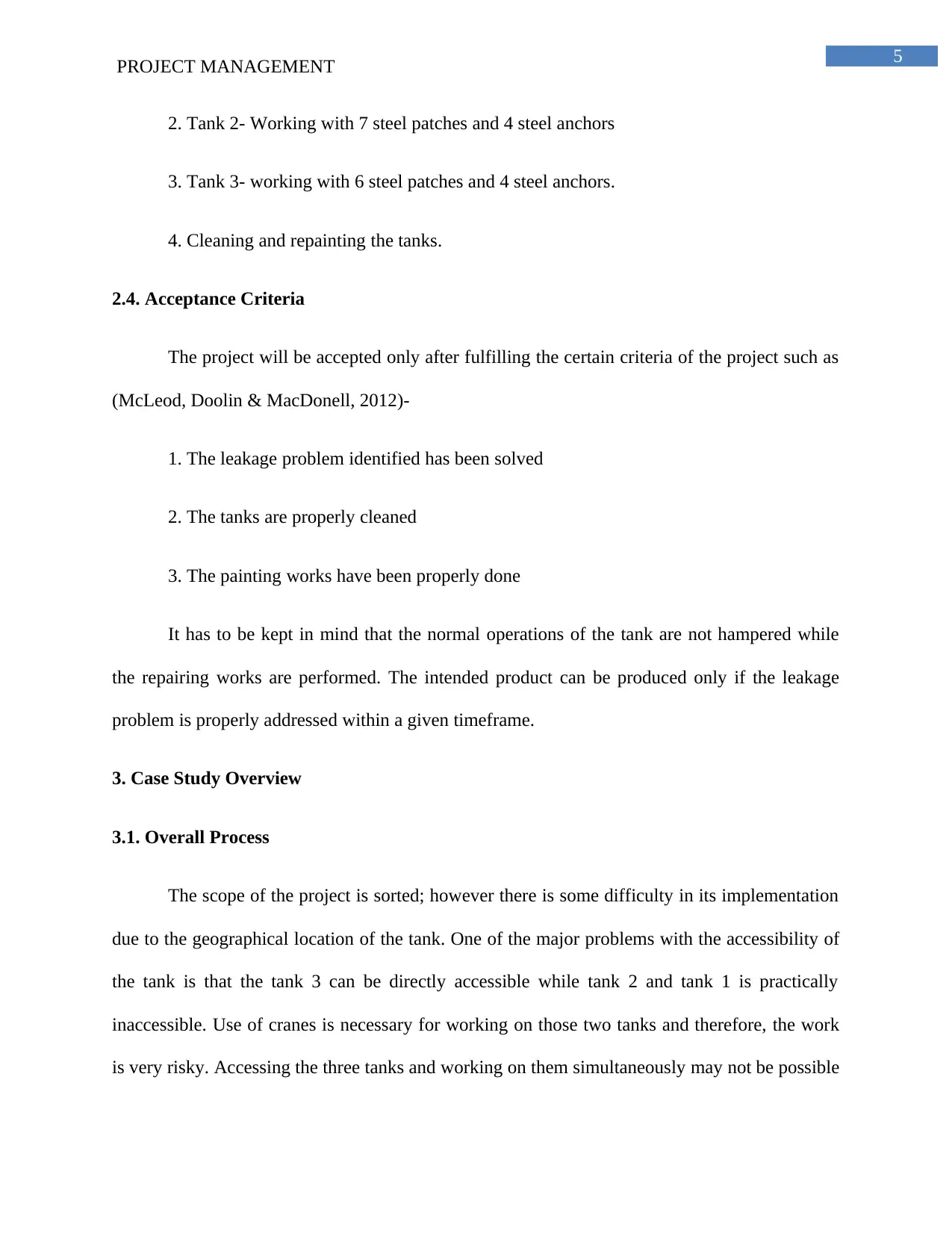
5
PROJECT MANAGEMENT
2. Tank 2- Working with 7 steel patches and 4 steel anchors
3. Tank 3- working with 6 steel patches and 4 steel anchors.
4. Cleaning and repainting the tanks.
2.4. Acceptance Criteria
The project will be accepted only after fulfilling the certain criteria of the project such as
(McLeod, Doolin & MacDonell, 2012)-
1. The leakage problem identified has been solved
2. The tanks are properly cleaned
3. The painting works have been properly done
It has to be kept in mind that the normal operations of the tank are not hampered while
the repairing works are performed. The intended product can be produced only if the leakage
problem is properly addressed within a given timeframe.
3. Case Study Overview
3.1. Overall Process
The scope of the project is sorted; however there is some difficulty in its implementation
due to the geographical location of the tank. One of the major problems with the accessibility of
the tank is that the tank 3 can be directly accessible while tank 2 and tank 1 is practically
inaccessible. Use of cranes is necessary for working on those two tanks and therefore, the work
is very risky. Accessing the three tanks and working on them simultaneously may not be possible
PROJECT MANAGEMENT
2. Tank 2- Working with 7 steel patches and 4 steel anchors
3. Tank 3- working with 6 steel patches and 4 steel anchors.
4. Cleaning and repainting the tanks.
2.4. Acceptance Criteria
The project will be accepted only after fulfilling the certain criteria of the project such as
(McLeod, Doolin & MacDonell, 2012)-
1. The leakage problem identified has been solved
2. The tanks are properly cleaned
3. The painting works have been properly done
It has to be kept in mind that the normal operations of the tank are not hampered while
the repairing works are performed. The intended product can be produced only if the leakage
problem is properly addressed within a given timeframe.
3. Case Study Overview
3.1. Overall Process
The scope of the project is sorted; however there is some difficulty in its implementation
due to the geographical location of the tank. One of the major problems with the accessibility of
the tank is that the tank 3 can be directly accessible while tank 2 and tank 1 is practically
inaccessible. Use of cranes is necessary for working on those two tanks and therefore, the work
is very risky. Accessing the three tanks and working on them simultaneously may not be possible
⊘ This is a preview!⊘
Do you want full access?
Subscribe today to unlock all pages.

Trusted by 1+ million students worldwide
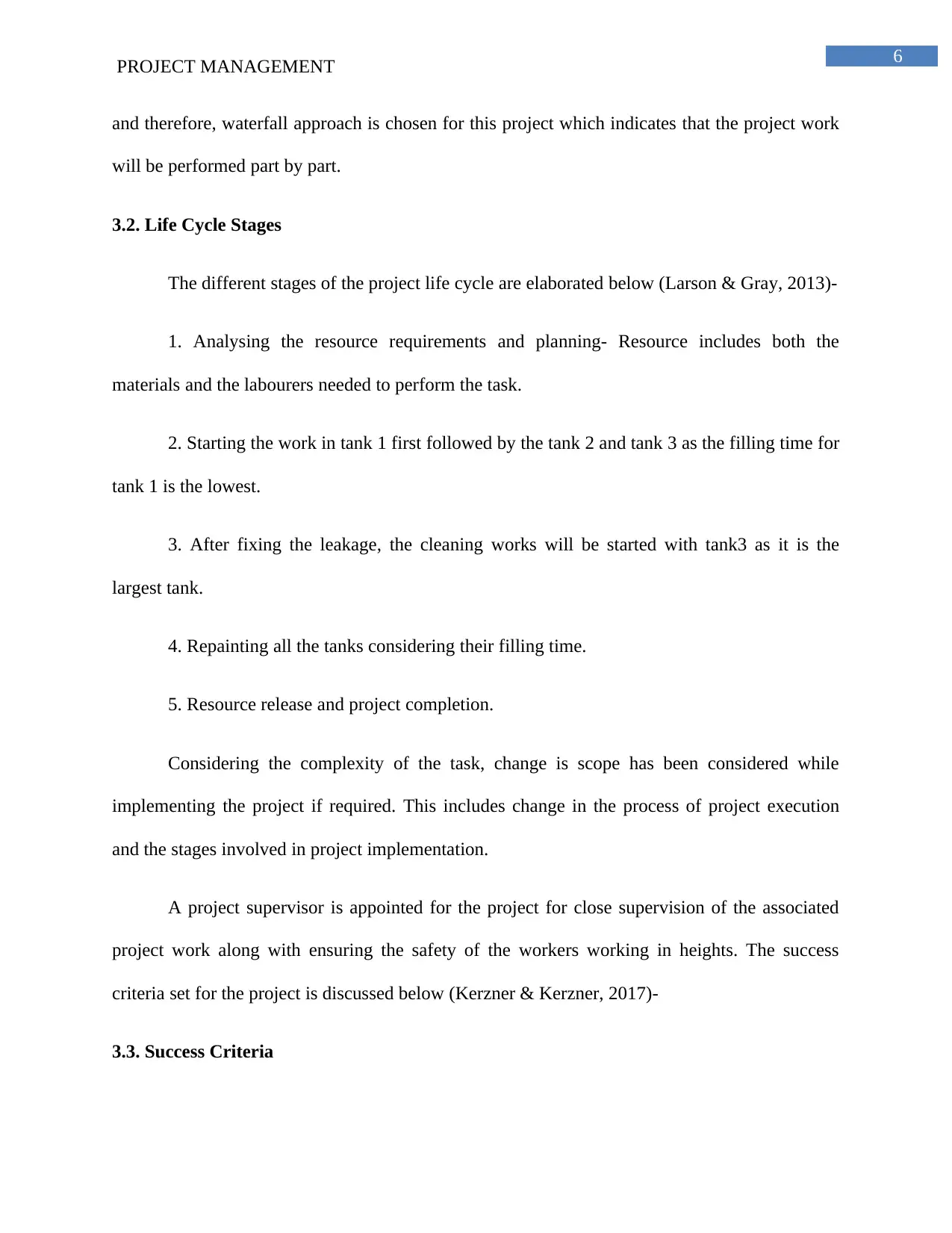
6
PROJECT MANAGEMENT
and therefore, waterfall approach is chosen for this project which indicates that the project work
will be performed part by part.
3.2. Life Cycle Stages
The different stages of the project life cycle are elaborated below (Larson & Gray, 2013)-
1. Analysing the resource requirements and planning- Resource includes both the
materials and the labourers needed to perform the task.
2. Starting the work in tank 1 first followed by the tank 2 and tank 3 as the filling time for
tank 1 is the lowest.
3. After fixing the leakage, the cleaning works will be started with tank3 as it is the
largest tank.
4. Repainting all the tanks considering their filling time.
5. Resource release and project completion.
Considering the complexity of the task, change is scope has been considered while
implementing the project if required. This includes change in the process of project execution
and the stages involved in project implementation.
A project supervisor is appointed for the project for close supervision of the associated
project work along with ensuring the safety of the workers working in heights. The success
criteria set for the project is discussed below (Kerzner & Kerzner, 2017)-
3.3. Success Criteria
PROJECT MANAGEMENT
and therefore, waterfall approach is chosen for this project which indicates that the project work
will be performed part by part.
3.2. Life Cycle Stages
The different stages of the project life cycle are elaborated below (Larson & Gray, 2013)-
1. Analysing the resource requirements and planning- Resource includes both the
materials and the labourers needed to perform the task.
2. Starting the work in tank 1 first followed by the tank 2 and tank 3 as the filling time for
tank 1 is the lowest.
3. After fixing the leakage, the cleaning works will be started with tank3 as it is the
largest tank.
4. Repainting all the tanks considering their filling time.
5. Resource release and project completion.
Considering the complexity of the task, change is scope has been considered while
implementing the project if required. This includes change in the process of project execution
and the stages involved in project implementation.
A project supervisor is appointed for the project for close supervision of the associated
project work along with ensuring the safety of the workers working in heights. The success
criteria set for the project is discussed below (Kerzner & Kerzner, 2017)-
3.3. Success Criteria
Paraphrase This Document
Need a fresh take? Get an instant paraphrase of this document with our AI Paraphraser
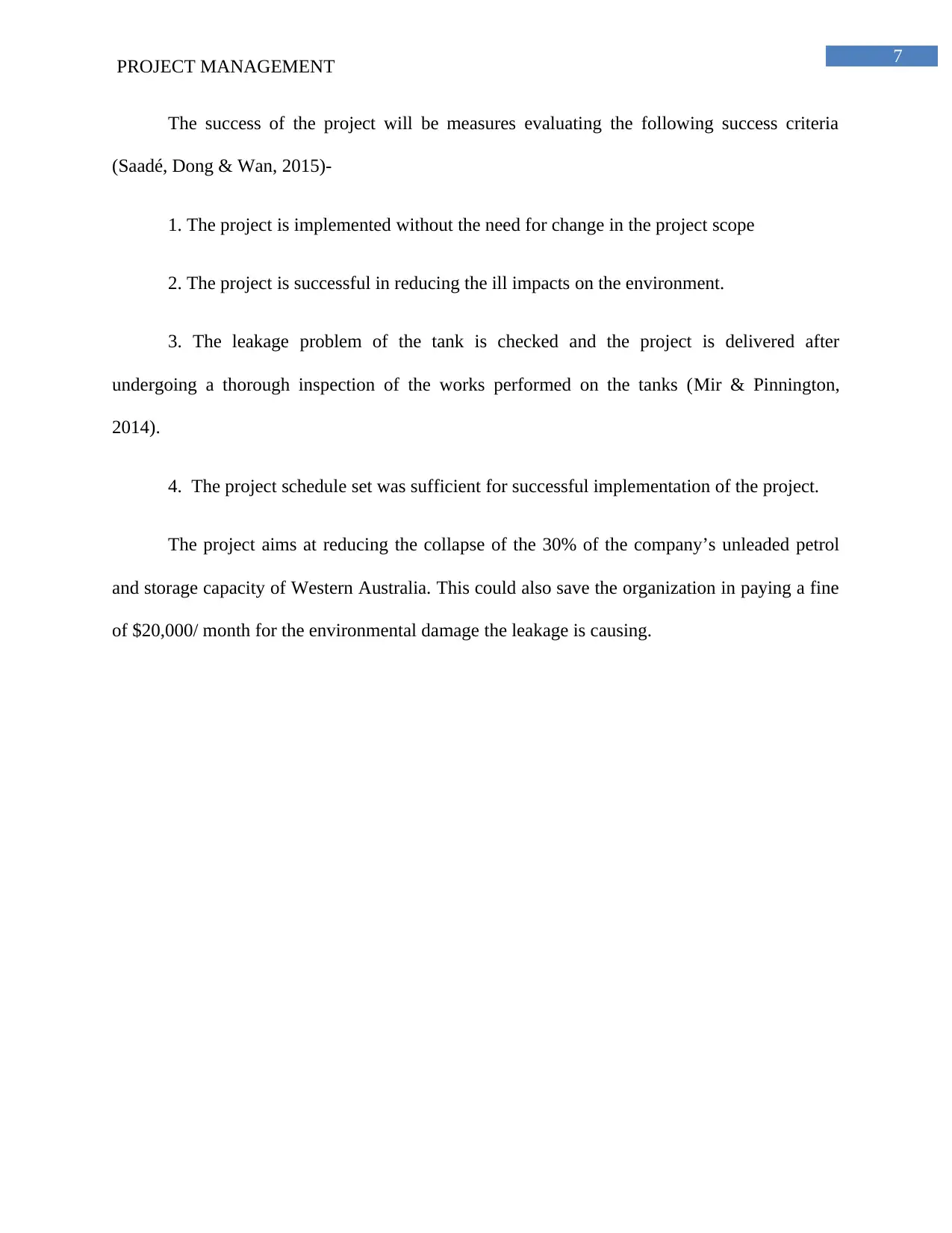
7
PROJECT MANAGEMENT
The success of the project will be measures evaluating the following success criteria
(Saadé, Dong & Wan, 2015)-
1. The project is implemented without the need for change in the project scope
2. The project is successful in reducing the ill impacts on the environment.
3. The leakage problem of the tank is checked and the project is delivered after
undergoing a thorough inspection of the works performed on the tanks (Mir & Pinnington,
2014).
4. The project schedule set was sufficient for successful implementation of the project.
The project aims at reducing the collapse of the 30% of the company’s unleaded petrol
and storage capacity of Western Australia. This could also save the organization in paying a fine
of $20,000/ month for the environmental damage the leakage is causing.
PROJECT MANAGEMENT
The success of the project will be measures evaluating the following success criteria
(Saadé, Dong & Wan, 2015)-
1. The project is implemented without the need for change in the project scope
2. The project is successful in reducing the ill impacts on the environment.
3. The leakage problem of the tank is checked and the project is delivered after
undergoing a thorough inspection of the works performed on the tanks (Mir & Pinnington,
2014).
4. The project schedule set was sufficient for successful implementation of the project.
The project aims at reducing the collapse of the 30% of the company’s unleaded petrol
and storage capacity of Western Australia. This could also save the organization in paying a fine
of $20,000/ month for the environmental damage the leakage is causing.
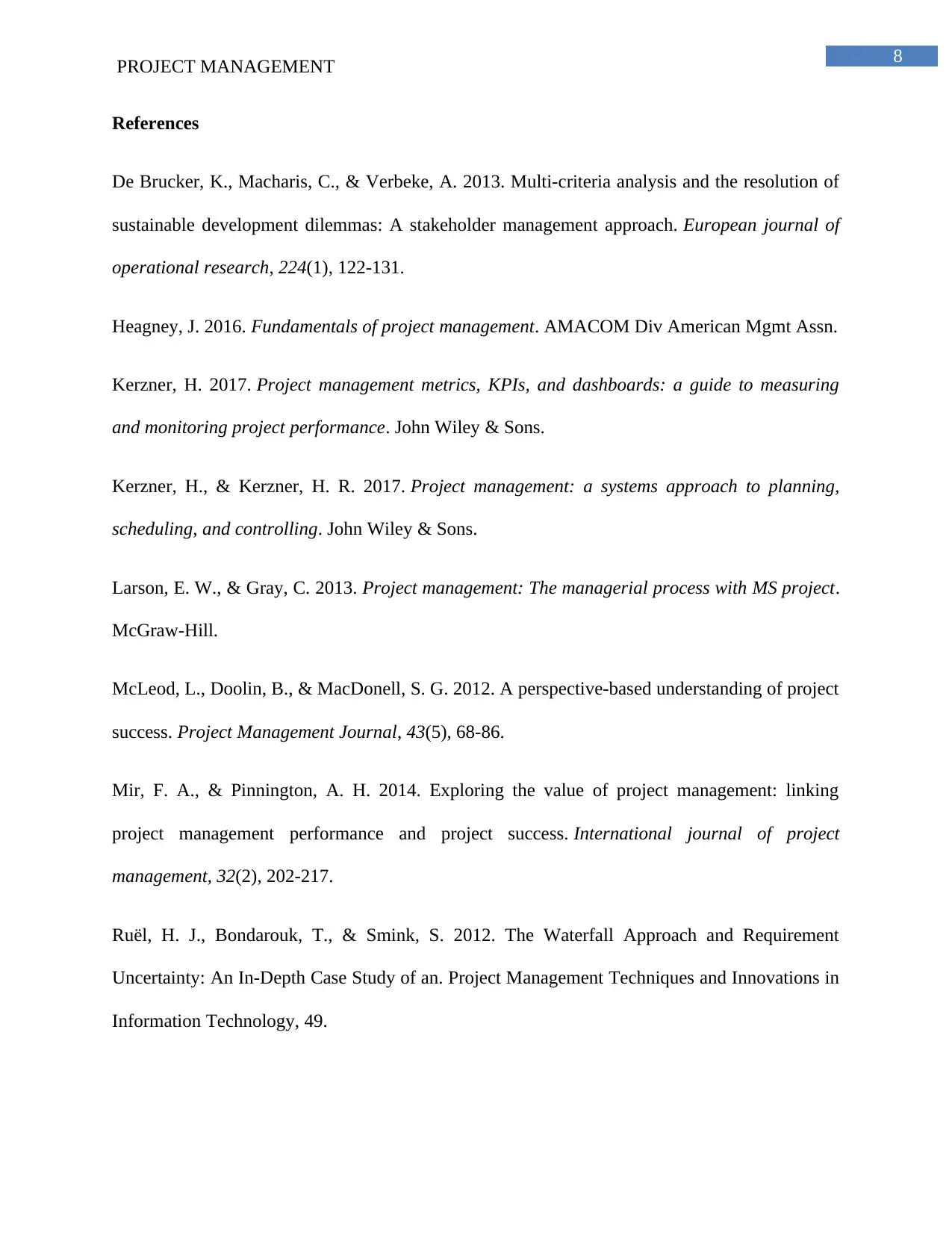
8
PROJECT MANAGEMENT
References
De Brucker, K., Macharis, C., & Verbeke, A. 2013. Multi-criteria analysis and the resolution of
sustainable development dilemmas: A stakeholder management approach. European journal of
operational research, 224(1), 122-131.
Heagney, J. 2016. Fundamentals of project management. AMACOM Div American Mgmt Assn.
Kerzner, H. 2017. Project management metrics, KPIs, and dashboards: a guide to measuring
and monitoring project performance. John Wiley & Sons.
Kerzner, H., & Kerzner, H. R. 2017. Project management: a systems approach to planning,
scheduling, and controlling. John Wiley & Sons.
Larson, E. W., & Gray, C. 2013. Project management: The managerial process with MS project.
McGraw-Hill.
McLeod, L., Doolin, B., & MacDonell, S. G. 2012. A perspective‐based understanding of project
success. Project Management Journal, 43(5), 68-86.
Mir, F. A., & Pinnington, A. H. 2014. Exploring the value of project management: linking
project management performance and project success. International journal of project
management, 32(2), 202-217.
Ruël, H. J., Bondarouk, T., & Smink, S. 2012. The Waterfall Approach and Requirement
Uncertainty: An In-Depth Case Study of an. Project Management Techniques and Innovations in
Information Technology, 49.
PROJECT MANAGEMENT
References
De Brucker, K., Macharis, C., & Verbeke, A. 2013. Multi-criteria analysis and the resolution of
sustainable development dilemmas: A stakeholder management approach. European journal of
operational research, 224(1), 122-131.
Heagney, J. 2016. Fundamentals of project management. AMACOM Div American Mgmt Assn.
Kerzner, H. 2017. Project management metrics, KPIs, and dashboards: a guide to measuring
and monitoring project performance. John Wiley & Sons.
Kerzner, H., & Kerzner, H. R. 2017. Project management: a systems approach to planning,
scheduling, and controlling. John Wiley & Sons.
Larson, E. W., & Gray, C. 2013. Project management: The managerial process with MS project.
McGraw-Hill.
McLeod, L., Doolin, B., & MacDonell, S. G. 2012. A perspective‐based understanding of project
success. Project Management Journal, 43(5), 68-86.
Mir, F. A., & Pinnington, A. H. 2014. Exploring the value of project management: linking
project management performance and project success. International journal of project
management, 32(2), 202-217.
Ruël, H. J., Bondarouk, T., & Smink, S. 2012. The Waterfall Approach and Requirement
Uncertainty: An In-Depth Case Study of an. Project Management Techniques and Innovations in
Information Technology, 49.
⊘ This is a preview!⊘
Do you want full access?
Subscribe today to unlock all pages.

Trusted by 1+ million students worldwide
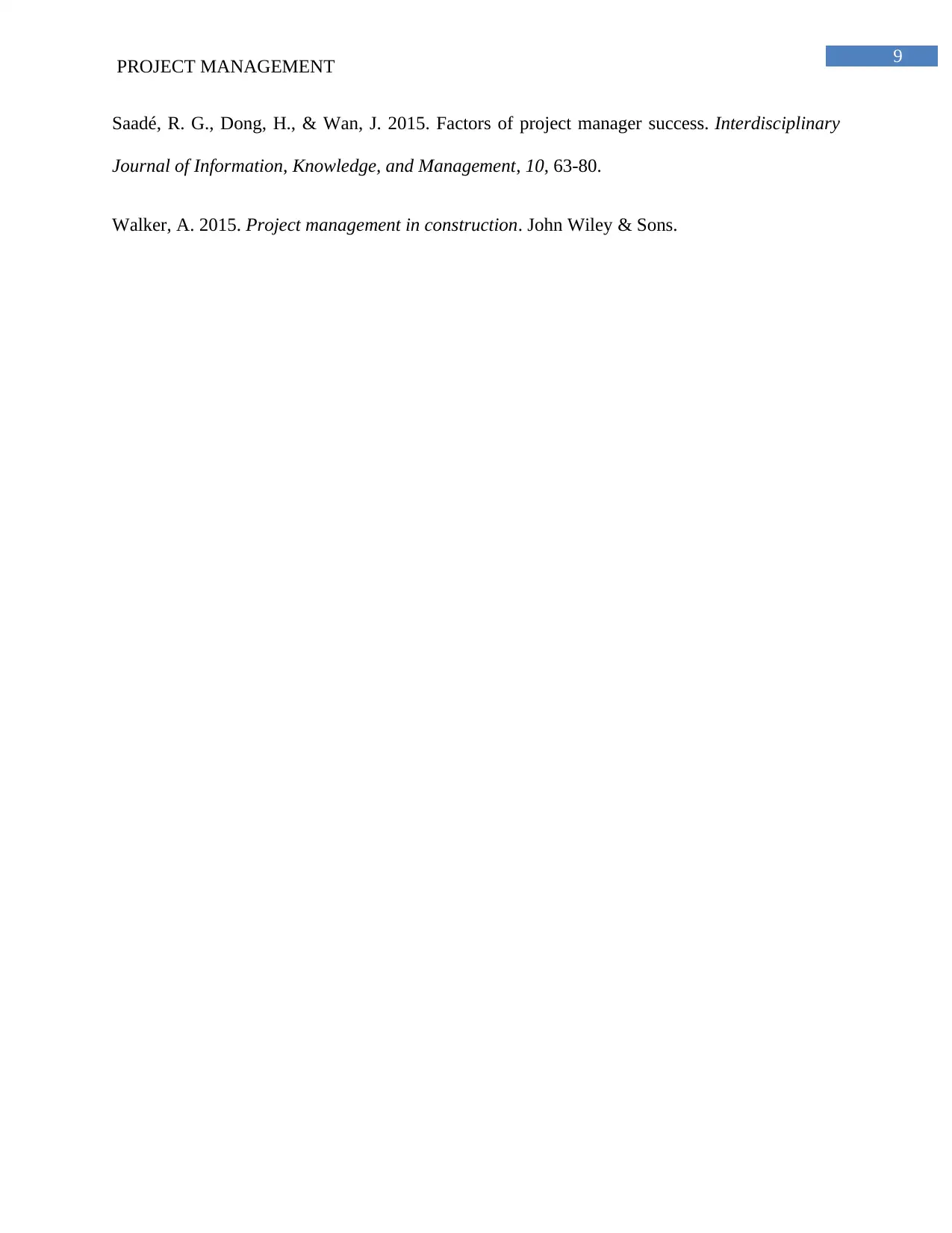
9
PROJECT MANAGEMENT
Saadé, R. G., Dong, H., & Wan, J. 2015. Factors of project manager success. Interdisciplinary
Journal of Information, Knowledge, and Management, 10, 63-80.
Walker, A. 2015. Project management in construction. John Wiley & Sons.
PROJECT MANAGEMENT
Saadé, R. G., Dong, H., & Wan, J. 2015. Factors of project manager success. Interdisciplinary
Journal of Information, Knowledge, and Management, 10, 63-80.
Walker, A. 2015. Project management in construction. John Wiley & Sons.
1 out of 10
Related Documents
Your All-in-One AI-Powered Toolkit for Academic Success.
+13062052269
info@desklib.com
Available 24*7 on WhatsApp / Email
![[object Object]](/_next/static/media/star-bottom.7253800d.svg)
Unlock your academic potential
Copyright © 2020–2025 A2Z Services. All Rights Reserved. Developed and managed by ZUCOL.




